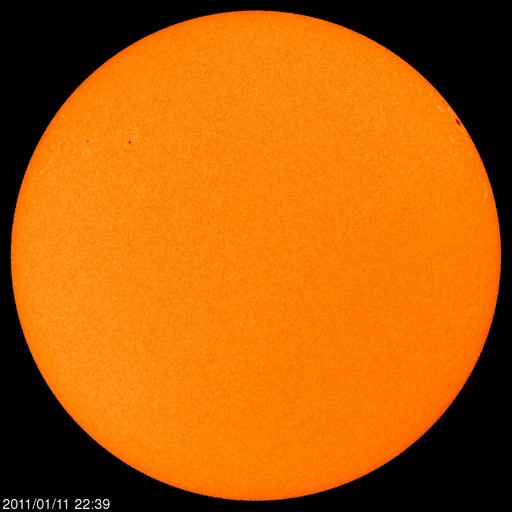The mystery of sunspots
Bernhard Fleck, ESA's project scientist for SOHO, comments, "The origin and stability of sunspots has been one of the long-standing mysteries in solar physics."
http://sse.jpl.nasa.gov/news/display.cfm?News_ID=2672
http://sse.jpl.nasa.gov/news/display.cfm?News_ID=2672
These spots are, actually, some meteorites and celestial rocks pulled from the space, by the gravity of the sun. Then the sun will swallow these rocks within few days.
The indication of this lies in:
· They disappear after few days when they will not be seen [afterwards], because the sun has swallowed them. If, really, these spots were due to the putting out of the sun, then they must increase a day after another until all the surface of the sun will be put out, when its Doomsday will take place.
[I may add also:
· They are colder than the rest of the solar body.
· They are depressed below the surface of the sun (saucer-shaped).
· There is the umbra (darker and colder), and the penumbra (less darker and less colder; or the penumbra is brighter and more hot than the umbra.)
· They are accompanied by severe disturbances in the solar activity, accompanied by magnetic field changes, that even affect the communication on Earth.]
Most of the meteorites and celestial rocks are obtained when one of the terrestrial planets of this sun will come to a standstill; that is because meteorites, celestial rocks and moons are attracted to planets, and when the planet will be depleted of its central heat, it will stop its axial rotation; for the same reason, its gravity will diminish then will be lost.
At that time the meteorites, celestial rocks and moons attracted by that planet will move towards the sun by its gravitational force, and the sun will swallow them.
· They are colder than the rest of the solar body.
· They are depressed below the surface of the sun (saucer-shaped).
· There is the umbra (darker and colder), and the penumbra (less darker and less colder; or the penumbra is brighter and more hot than the umbra.)
· They are accompanied by severe disturbances in the solar activity, accompanied by magnetic field changes, that even affect the communication on Earth.]
Most of the meteorites and celestial rocks are obtained when one of the terrestrial planets of this sun will come to a standstill; that is because meteorites, celestial rocks and moons are attracted to planets, and when the planet will be depleted of its central heat, it will stop its axial rotation; for the same reason, its gravity will diminish then will be lost.
At that time the meteorites, celestial rocks and moons attracted by that planet will move towards the sun by its gravitational force, and the sun will swallow them.
The large sunspot observed few years ago, and remained visible from Jan.28. to Feb.10 [ 1956: about 2 weeks) and was accompanied by the most severe electromagnetic storms; it must, undoubtedly, be a group of meteorites which were revolving around Venus. This Venus had its central heat finished, and it had lost its gravity, so that these meteorites escaped the gravity of Venus and were pulled by the gravitational force of the sun, which swallowed them in 2 weeks time.
Sunspots
http://universeandquran.741.com/new_page_4.htm#Sunspots
Sunspots
http://universeandquran.741.com/new_page_4.htm#Sunspots
The mistake of Astronomers concerning sunspots
http://universeandquran.741.com/new_page_4.htm#MistakeaboutSunspots
http://universeandquran.741.com/new_page_4.htm#MistakeaboutSunspots
This is confirmed by the most recent discovery of SOHO , which may be interpreted as such rocks, meteorites and [? moons] fall on the sun:
>> " A sunspot turns out to be a kind of whirlpool, where hot gas near the Sun's surface converges and dives into the interior at speeds of up to 4000 kilometres per hour."
>> " A sunspot turns out to be a kind of whirlpool, where hot gas near the Sun's surface converges and dives into the interior at speeds of up to 4000 kilometres per hour."
>> " The converging flows of gas around a spot, found by SOHO, explain why the magnetic fields become concentrated, and how a sunspot can persist for days or weeks."
>> "the Sun is actually brighter when it is freckled with dark spots."
>> "sunshine is slightly more intense at sunspot maximum"
"What is interesting from the physical point of view is that, being cool, the descending flow is readily able to extract the heat that accumulates beneath the spot," Gough says. "It then spreads the heat away from the sunspot and eventually brings it to the surface of the Sun far from the spot, from where it is radiated into space."
http://sse.jpl.nasa.gov/news/display.cfm?News_ID=2672
http://sse.jpl.nasa.gov/news/display.cfm?News_ID=2672
Last edited:



